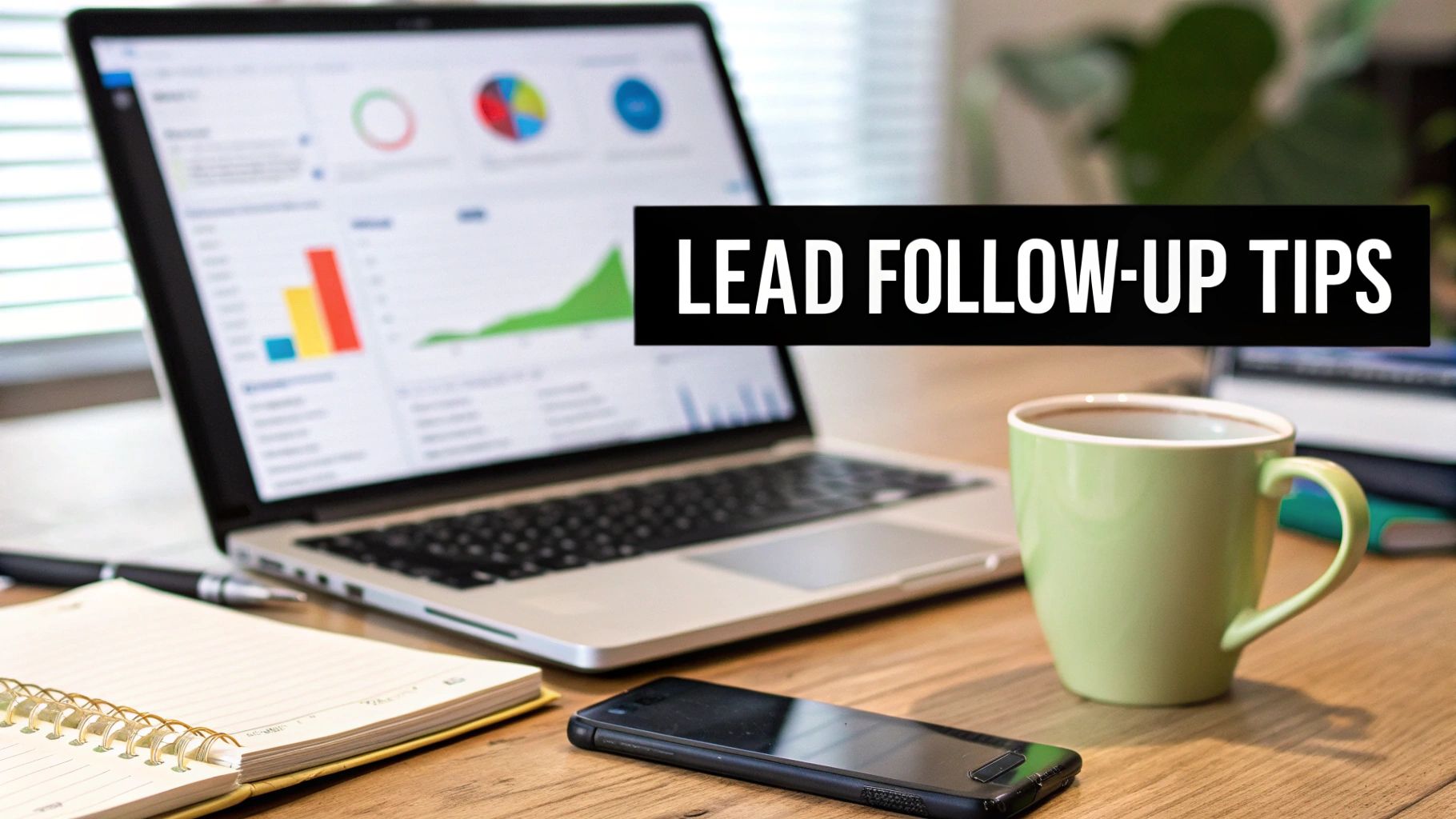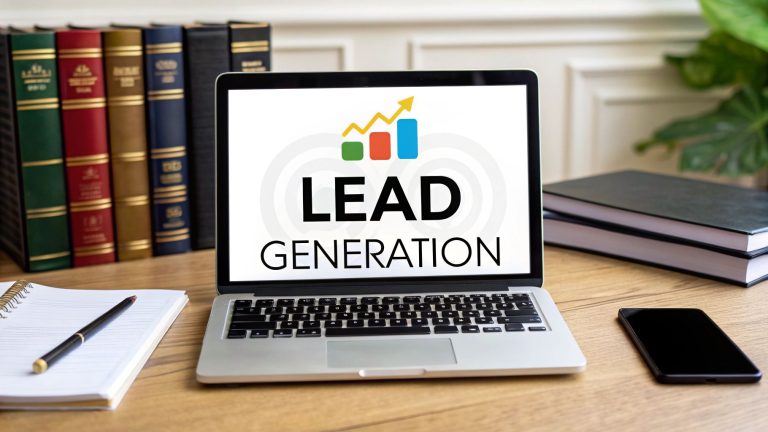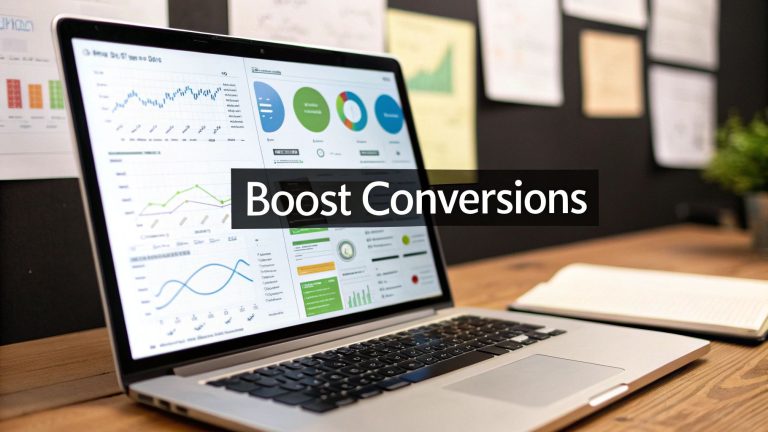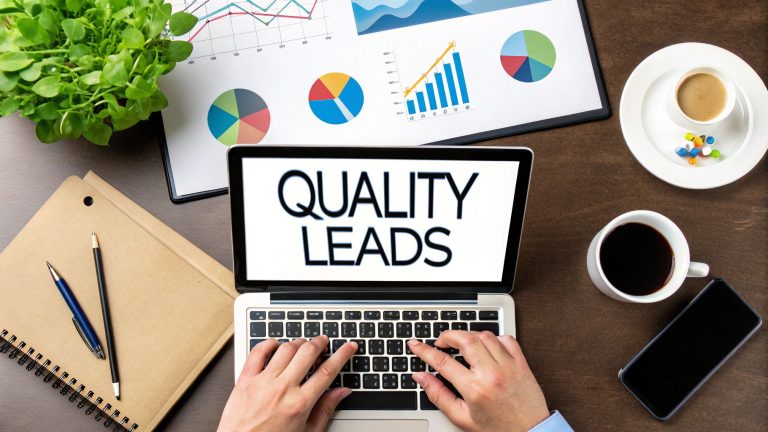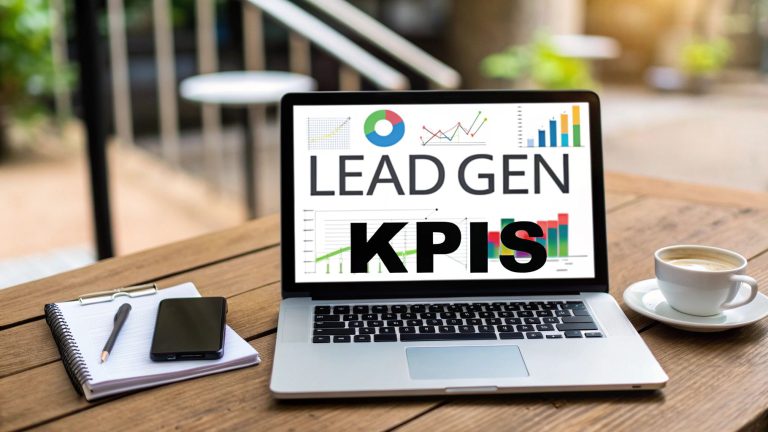7 Proven Lead Follow Up Best Practices for 2025
In the world of sales, generating leads is only half the battle. The real challenge, and where most revenue is won or lost, lies in the follow-up. A shocking number of promising leads go cold simply due to inconsistent, slow, or ineffective strategies. If your team is manually downloading lead lists from platforms like Facebook and struggling to keep up, you're not just losing time; you're actively losing customers.
Effective follow-up isn't just about persistence; it's a science built on speed, strategy, and delivering value. Neglecting this crucial stage means your marketing spend and hard-earned leads are leaking directly out of your sales pipeline. The gap between a new lead and a closed deal is bridged by a structured, timely, and relevant communication plan.
This guide moves beyond generic advice to provide a clear, actionable framework. We will break down the 7 most crucial lead follow up best practices that separate top-performing sales teams from the rest. By implementing these proven methods, you can stop the leaks in your pipeline, engage prospects meaningfully, and dramatically increase your conversion rates. Let’s dive into the specific tactics that turn interest into revenue.
1. Follow the Rule of Five
One of the most persistent myths in sales is that a great lead will convert on the first or second contact. Data tells a different story: most sales happen after multiple touchpoints. The "Rule of Five" is a systematic approach, popularized by sales experts at InsideSales.com and Outreach.io, that addresses this reality head-on. It establishes a structured sequence of five contact attempts over a set period, dramatically improving your odds of getting a response.
This method is one of the most effective lead follow up best practices because it acknowledges prospect behavior. Leads are busy, and your initial outreach might arrive at an inconvenient time. A persistent, value-driven sequence keeps your solution top-of-mind without being intrusive.
How to Implement the Rule of Five
A successful Rule of Five sequence mixes channels and adds value at each step. The key is to avoid sending the same "just checking in" message repeatedly. Instead, create a cadence that builds on the previous touchpoint.
For example, a B2B SaaS company might use a 10-day sequence like this:
- Day 1: Personalized initial email referencing the lead's specific action (e.g., a demo request or ebook download).
- Day 3: Follow-up email with a relevant case study or blog post.
- Day 5: Phone call or voicemail.
- Day 7: LinkedIn connection request with a brief, personalized message.
- Day 10: A final "breakup" email that offers one last piece of value and politely closes the loop.
This infographic breaks down the core components of a successful "Rule of Five" strategy and its potential impact.
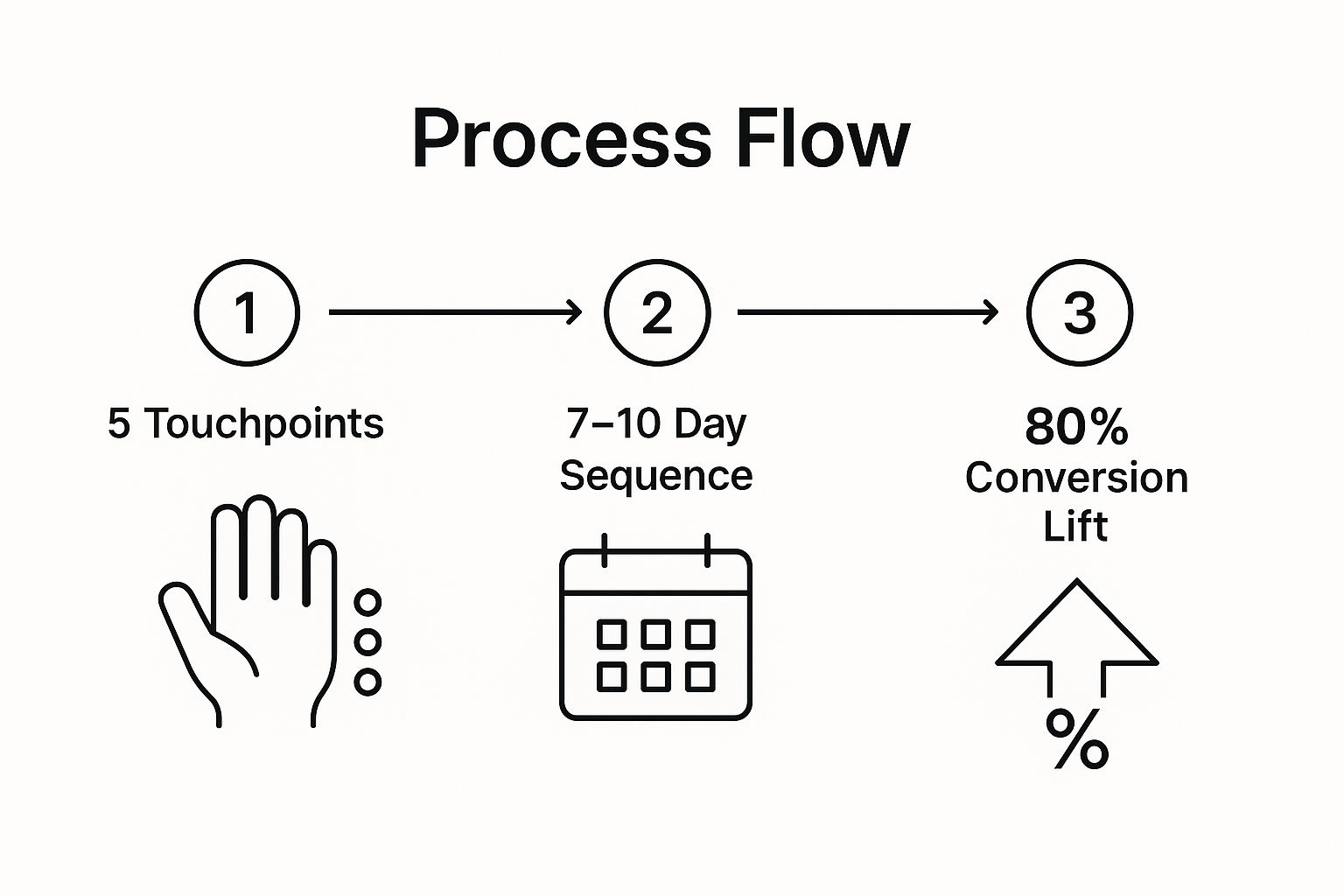
As visualized, structuring five touchpoints over a 7–10 day period can lead to a significant lift in conversions by ensuring persistent yet measured contact. This structured approach, used by teams at HubSpot and Salesforce, transforms follow-up from a guessing game into a repeatable, high-performance process.
2. Immediate Response Time (5-Minute Rule)
In the digital age, speed is the ultimate competitive advantage. The "5-Minute Rule" is a powerful principle in lead management, grounded in research showing that responding to an inbound lead within five minutes increases the odds of contacting them by 100 times and qualifying them by 21 times compared to waiting just 30 minutes. Popularized by Dr. James Oldroyd's seminal MIT study and championed by industry leaders like InsideSales.com, this rule capitalizes on peak prospect intent.
When a lead fills out a form, they are actively thinking about their problem and your potential solution. This brief window is when their interest is highest and their pain point is most acute. Waiting even a few minutes allows distractions to set in, competitors to reach out, and the initial urgency to fade. This immediate response is one of the most impactful lead follow up best practices because it meets the modern buyer's expectation for instant engagement.
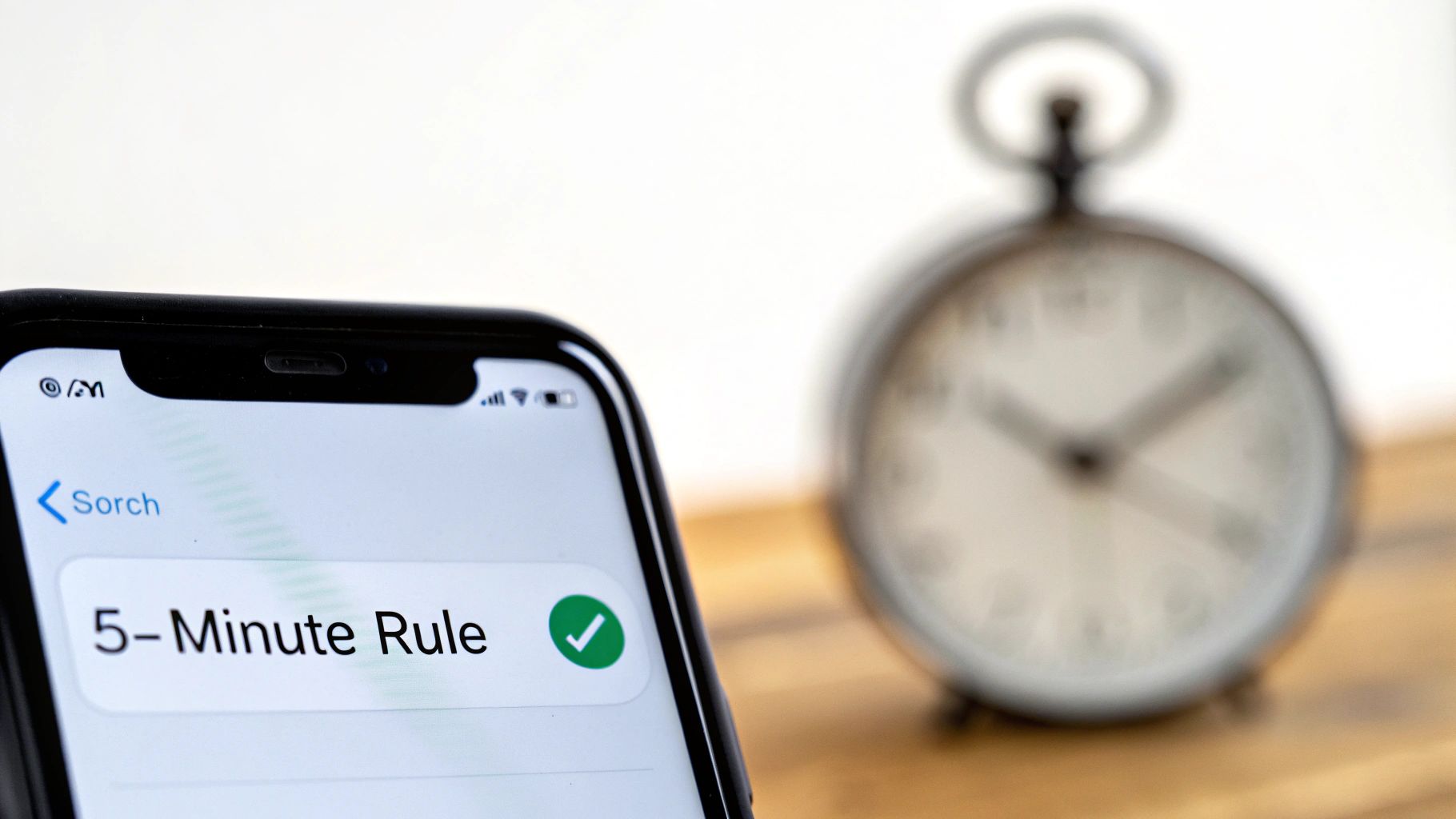
How to Implement the 5-Minute Rule
Successfully implementing this rule requires a combination of technology and process. It’s not just about speed; it's about building a system that makes a five-minute response the standard, not the exception.
Here’s how high-performing teams put this into practice:
- Set up instant lead alerts: Configure your CRM or lead management software to send immediate mobile push notifications or SMS alerts to the assigned sales representative the moment a new lead arrives.
- Use prepared templates: Create a series of pre-written but easily customizable email and text message templates. This allows reps to respond instantly with a relevant, personalized message without having to write it from scratch every time.
- Leverage automation strategically: Use chatbots, like those from Drift, to engage leads on your website immediately. The bot can qualify the lead with a few questions before routing the conversation to a live agent, all within the five-minute window.
- Implement lead rotation: For teams, a round-robin or lead rotation system ensures every new lead is assigned to an available rep instantly, preventing delays during busy periods or when a specific rep is unavailable.
Companies that master this create a powerful first impression that builds trust and momentum from the very first interaction. By tracking and rewarding team members who consistently meet this target, as done in Salesforce's high-velocity sales methodology, organizations can turn speed into a predictable and scalable revenue driver.
3. Implement a Multi-Channel Follow-Up Strategy
Relying solely on email for lead follow-up is like fishing with only one type of bait; you’ll miss a large portion of your potential catch. A multi-channel follow-up strategy acknowledges that prospects live and communicate across various platforms. By engaging leads through a mix of email, phone calls, social media, and even text messages, you meet them where they are most comfortable and active, significantly boosting your chances of connection.
This approach is one of the most effective lead follow up best practices because it breaks through the noise. A prospect might ignore an email but respond to a LinkedIn message, or miss a phone call but read a text. Pioneers in sales engagement like Outreach.io and SalesLoft have proven that using four or more channels can result in 50% higher response rates compared to a single-channel approach. This method diversifies your outreach, making your follow-up efforts more resilient and effective.
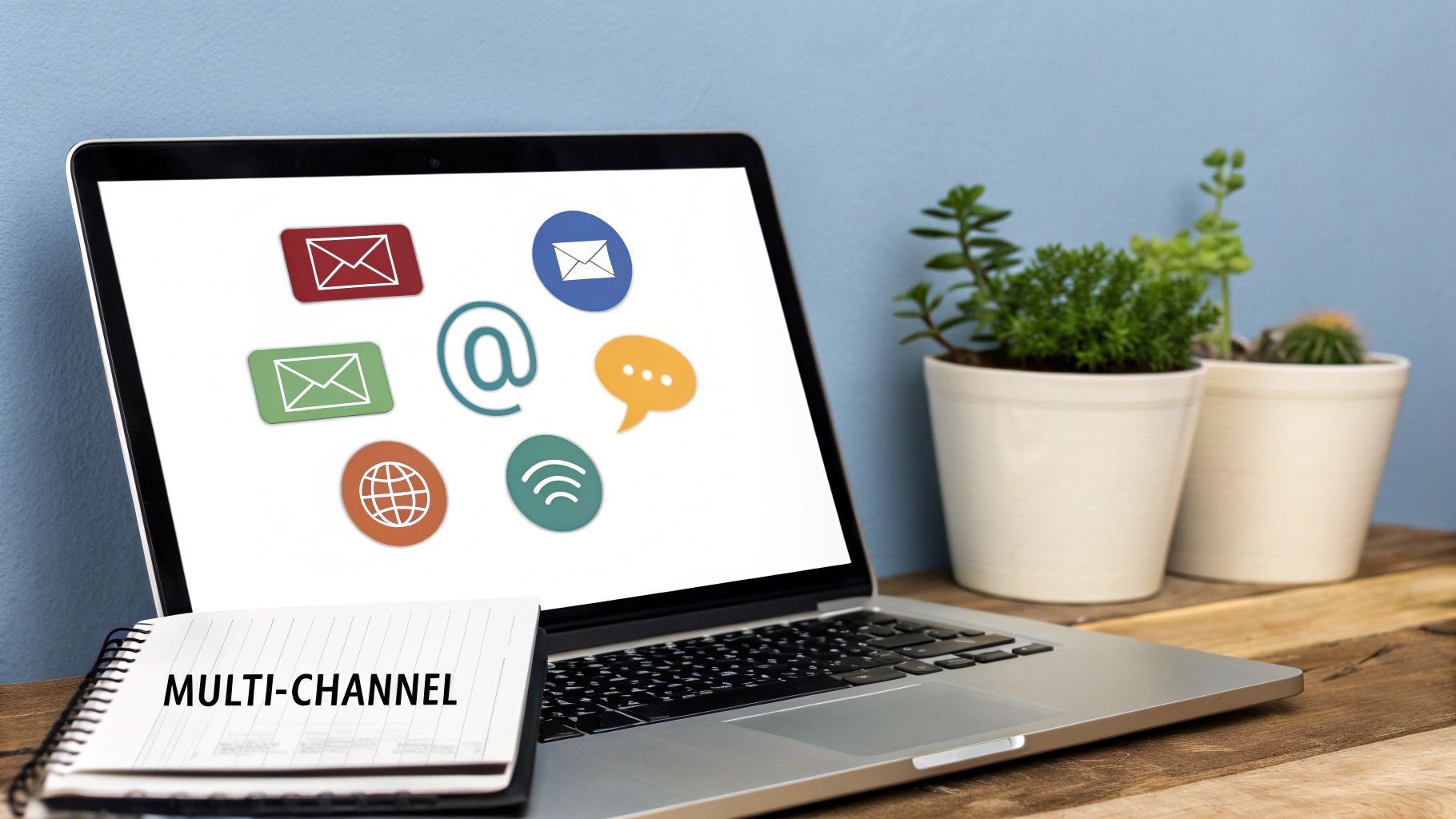
How to Implement a Multi-Channel Strategy
The key to a successful multi-channel strategy is orchestration. Each touchpoint should feel like part of a cohesive conversation, not a random barrage of messages. Integrating your efforts through a CRM is crucial for coordinating timing and messaging across different platforms.
Here is how a real estate company like Compass might apply this for a new property inquiry:
- Initial Contact (First 5 Mins): Automated email with property details and an introductory SMS message.
- Day 2: A personal phone call to answer immediate questions and offer a viewing.
- Day 4: A follow-up email with a link to a virtual tour or similar properties. See some powerful sales follow up email examples to craft your messaging.
- Day 6: Connect on a professional social platform like LinkedIn or engage with their public social media profile if appropriate.
- Day 8: Final personal email offering a last chance for a private tour before closing the loop.
This layered approach, championed in frameworks like Aaron Ross's 'Predictable Revenue,' ensures persistent, value-added contact. By tracking which channels yield the best results for specific lead segments, you can continuously refine your strategy for maximum impact, turning a simple follow-up process into a powerful conversion engine.
4. Provide Value in Every Follow-Up
The era of the generic "just checking in" email is over. Modern prospects expect more than a simple nudge; they want substance. A value-added follow-up strategy transforms your outreach from an interruption into a welcomed resource. This approach, championed by content marketing pioneers like Joe Pulizzi and integrated into HubSpot's inbound methodology, centers on providing useful, relevant content at each touchpoint.
This is one of the most crucial lead follow up best practices because it shifts the dynamic from seller-to-buyer to advisor-to-partner. By consistently offering value without an immediate ask, you build trust, demonstrate expertise, and keep your brand top-of-mind. This method nurtures the lead by educating them, making the eventual sales conversation much more informed and effective.
How to Implement Value-Added Follow-Up
The core principle is to make every interaction an opportunity to help your prospect solve a problem or learn something new. Instead of just asking for their time, you earn it by giving them something valuable first. This requires a well-organized library of content assets tailored to different buyer personas and stages of the funnel.
For example, a marketing agency could use a value-added sequence like this:
- Touchpoint 1: Send an email referencing their recent download and include a link to a highly relevant blog post that expands on the topic.
- Touchpoint 2: Share a third-party industry report or benchmark data that validates the challenges your service addresses. Add a brief, personalized note: "Thought this data on [specific challenge] might be insightful for your team."
- Touchpoint 3: Offer a proprietary template, checklist, or tool that helps them with a specific task. For example, a content planning template.
- Touchpoint 4: Invite them to a free webinar or send a recording of a past session that dives deep into a pain point you've identified through your research.
This approach has been proven highly effective. Marketing agency Influence & Co. reports achieving 65% response rates by sharing custom industry insights. Similarly, HubSpot saw 40% higher engagement by incorporating relevant content into its follow-up cadences. For more guidance on structuring these messages, you can find a variety of lead nurturing email templates on leadsavvy.pro.
5. Personalization and Research-Based Outreach
In a world saturated with generic outreach, personalization isn't just a tactic; it's a fundamental requirement. Research-based outreach moves beyond simply using a prospect's first name. It involves a deep dive into their specific context to create a message that is undeniably relevant and demonstrates genuine interest. This method, championed by social selling experts like Jamie Shanks and sales pioneer Aaron Ross, is one of the most powerful lead follow up best practices for cutting through the noise.
Generic follow-ups signal that you haven't done your homework and are just another salesperson in their inbox. A well-researched, personalized message proves you understand their world, their challenges, and their recent activities, immediately elevating the conversation from a cold pitch to a potential partnership.
How to Implement Research-Based Outreach
Effective personalization requires a systematic approach to gathering and applying intelligence. The goal is to connect your solution directly to a specific, timely trigger event or piece of information you've discovered about the prospect or their company. This transforms your follow-up from "checking in" to "reaching out because…"
For example, a sales development representative (SDR) could implement this strategy as follows:
- Trigger: A target company announces a new funding round on TechCrunch.
- Research: The SDR uses LinkedIn Sales Navigator to identify the VP of Operations and notices they recently shared a post about scaling their team efficiently.
- Outreach: The SDR sends a personalized email: "Hi [Prospect Name], saw the news about your Series B funding – congratulations! I noticed your recent post on scaling your operations. Many fast-growing companies like yours use our platform to automate [specific process] to support that exact kind of growth. Is that a priority for you in the next quarter?"
This approach is highly effective. The B2B agency Predictable Revenue, for instance, personalizes emails based on mutual connections and other triggers, achieving a 50% higher response rate compared to non-personalized messages. Similarly, teams at Gong.io are known for referencing specific company expansions in their outreach to make it hyper-relevant. This level of detail makes your follow-up feel less like a sales attempt and more like a well-timed, consultative suggestion.
6. Progressive Information Gathering
Trying to learn everything about a lead in the first interaction is a common mistake that can feel like an interrogation and scare them away. Progressive information gathering is a strategic approach where you collect details about a prospect incrementally over multiple touchpoints. This method, rooted in qualification frameworks like BANT developed at IBM, builds rapport naturally while systematically qualifying the lead.
This technique is one of the most effective lead follow up best practices because it respects the prospect's time and builds trust. Instead of demanding a prospect complete a lengthy form or answer a barrage of questions upfront, you earn the right to ask for more information by providing value at each step. This transforms the sales process from a transaction into a collaborative conversation.
How to Implement Progressive Information Gathering
The key is to map out the critical information you need and strategically sequence your questions across your follow-up cadence. Each interaction should have a clear goal for both providing value and gathering a new piece of the puzzle. Referencing previously shared information in later conversations shows you are listening and helps build a stronger connection.
For example, a consulting firm could structure their information gathering like this:
- Contact 1 (Initial Email): Confirm their primary challenge based on the content they downloaded.
- Contact 2 (First Call): Discuss the immediate impact of that challenge and ask about their desired timeline for a solution.
- Contact 3 (Follow-up Call): Reference the timeline and ask about their budget allocation for this type of initiative.
- Contact 4 (Demo/Proposal): Confirm the key decision-makers who need to be involved based on the budget and timeline.
As championed by sales experts like Andy Paul and the authors of The Challenger Sale, this approach allows you to tailor your pitch with increasing precision. Companies like HubSpot and McKinsey use this method to build detailed client profiles, ensuring their proposed solutions are perfectly aligned with the prospect's specific needs, budget, and authority structure. This makes the final ask more relevant and likely to succeed.
7. Automated Follow-Up Sequences with Human Touch
Scaling your outreach doesn't mean you have to sacrifice personalization. The most effective lead follow up best practices combine the efficiency of automation with the authenticity of human interaction. This hybrid approach uses technology to handle repetitive tasks while creating strategic moments for a salesperson to add a genuine, human touch.
This method, championed by platforms like HubSpot and Salesforce Pardot, allows you to nurture leads at scale without sounding robotic. By automating the initial stages of a sequence, you ensure every lead receives a timely response, while freeing up your team to focus on high-intent prospects who show engagement. It's a system that marries consistency with customization.
How to Implement Automated Sequences with a Human Touch
The goal is to design workflows that automatically trigger follow-ups but also alert a human when manual intervention is needed. This creates a scalable yet personal experience that builds rapport and drives conversions.
For example, a marketing agency could set up this type of sequence:
- Trigger: A lead downloads a whitepaper on "SEO for Local Businesses."
- Automated Step 1: An immediate email is sent with a link to the whitepaper and a thank you message.
- Automated Step 2 (Day 3): A follow-up email is automatically sent, offering a related blog post titled "5 Common SEO Mistakes Local Businesses Make."
- Human Intervention Point (Day 5): If the lead clicks the link in the second email, a notification is sent directly to a sales representative. The rep can then send a highly personalized message like, "I saw you were interested in our SEO content. I noticed on your website that you're not using schema markup, which is a huge opportunity for local businesses. Have 15 minutes to chat about it next week?"
This strategy is highly effective. Marketo's use of automated nurturing has been shown to increase qualified leads by 451%, and Salesforce customers using Pardot automation report a 37% higher win rate. For a deeper dive into building these types of workflows, you can explore some effective marketing automation workflow examples on leadsavvy.pro.
To get started, begin with simple sequences and gradually add complexity. Always include clear opt-out options, and regularly test different timings and content. Most importantly, monitor engagement signals to identify the perfect moment for a human to step in and close the deal.
Lead Follow-Up Best Practices Comparison
| Follow-Up Strategy | Implementation Complexity 🔄 | Resource Requirements ⚡ | Expected Outcomes 📊 | Ideal Use Cases 💡 | Key Advantages ⭐ |
|---|---|---|---|---|---|
| Follow the Rule of Five | Medium – requires tracking & timing | Moderate – multi-channel effort | +80% conversion lift with 5 touchpoints | Teams aiming for systematic persistence in lead follow-up | Systematic, persistent approach; measurable improvement |
| Immediate Response Time (5-Minute Rule) | High – requires constant monitoring | High – fast alerts & rotation | Up to 900% higher contact rates | High-velocity sales needing instant engagement | Captures hot leads early; reduces competition |
| Multi-Channel Follow-Up Strategy | High – complex coordination | High – multiple platforms | +160% response rates | Diverse prospect preferences; broad outreach campaigns | Flexible; accommodates preferences; multiple touchpoints |
| Value-Added Follow-Up Content | Medium-High – content creation | High – tailored content | Increased engagement; builds trust | Thought leadership-driven sales; education-focused prospects | Positions as expert; differentiates from competitors |
| Personalization and Research-Based Outreach | Very High – extensive research | High – requires tools & time | +142% response rates | High-value prospects requiring customized approach | Builds genuine interest; stronger relationships |
| Progressive Information Gathering | Medium-High – multi-stage process | Medium – CRM and tracking tools | Better qualification accuracy | Complex sales needing staged qualification before closing | Deep qualification; reduces friction |
| Automated Follow-Up Sequences with Human Touch | High – setup & testing involved | Medium-High – automation tools | Increased qualified leads; scalable follow-up | Large lead volume needing scale + personalization | Scalable yet personal; consistent; analytics-driven |
From Strategy to Action: Automating Your Follow-Up Success
Mastering the art and science of lead follow up is not just about adopting a few new tactics; it's about fundamentally re-engineering your sales process into a predictable engine for growth. Throughout this guide, we've explored a comprehensive framework of lead follow up best practices, moving from foundational principles to sophisticated, multi-touch strategies. Each practice, whether it's the immediacy of the "5-Minute Rule" or the nuanced approach of value-added content, contributes to a single, powerful outcome: building meaningful connections that convert prospects into loyal customers.
The common thread weaving through all these strategies is the non-negotiable need for speed, consistency, and personalization. You now understand the critical importance of reaching out within those first golden minutes, the strategic advantage of a multi-channel approach, and the necessity of personalizing every interaction.
Turning Knowledge into Conversion
The gap between knowing these best practices and executing them flawlessly is where most businesses falter. It's one thing to know you should contact a lead from a Facebook Ad in five minutes; it's another to have a system that makes it possible every single time, without fail. Manually downloading lead data, formatting it, and distributing it to your sales team introduces fatal delays and human error, effectively undermining your entire follow-up effort before it even begins.
This is precisely where automation serves as the bridge from strategy to action. Implementing technology isn't about replacing the human element; it's about empowering it. By automating the tedious, time-sensitive tasks that create friction in your workflow, you free your team to focus on what they do best:
- Building Rapport: Salespeople can spend their time researching a lead and personalizing their message instead of wrestling with a CSV file.
- Adding Value: They can focus on creating and sharing insightful content rather than just trying to make initial contact.
- Closing Deals: Their energy is directed toward high-value conversations, not low-value administrative work.
Your Actionable Path Forward
Transforming your follow-up process doesn't require a complete overhaul overnight. Start by choosing one or two practices from this article that will have the biggest impact on your current operations. Perhaps it's committing to the 5-Minute Rule or designing your first value-added email sequence.
Once you’ve identified your starting point, audit your current workflow. Where are the bottlenecks? Is lead data stuck in your ad platform? Are notifications reaching your team too slowly? This is your opportunity to integrate a tool specifically designed to eliminate that initial friction. Automating lead retrieval and notification is the single most effective step you can take to ensure the lead follow up best practices you've learned become a consistent reality, not just a goal. By building your strategy on a foundation of speed and reliability, you set the stage for sustained growth and a dramatically improved return on your marketing investment.
Ready to eliminate the delay between lead generation and sales action? LeadSavvy Pro instantly syncs your Facebook leads directly to your email, CRM, or Google Sheets, empowering your team to follow up in seconds, not hours. Start your free trial of LeadSavvy Pro today and turn these best practices into your competitive advantage.

